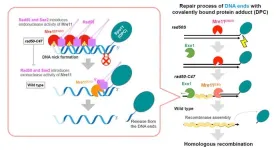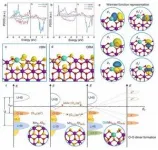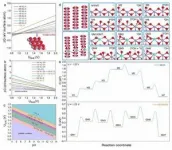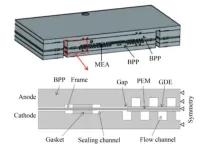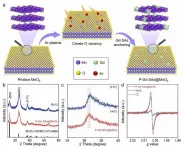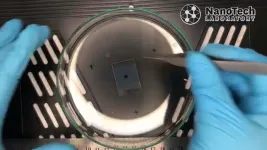Shedding light on the mechanism of yeast DNA repair
Researchers investigate the central role of Sae2, a protein in budding yeast, in regulating the DNA repair mechanism in yeast.
2024-08-29
(Press-News.org)
DNA damage is a cellular phenomenon that introduces structural abnormalities in double-stranded DNA. External factors, such as radiation or chemical agents, as well as internal factors, such as blocked DNA replication, can generate double-strand breaks (DSBs) in DNA. To counteract DNA damage, cells engage in DNA repair to preserve genetic integrity and ensure cell survival as failure to repair DSBs has serious health complications like increased risk of cancer.
DSBs are repaired by two mechanisms called non-homologous end joining (NHEJ) and homologous recombination (HR). NHEJ is the predominant DNA repair mechanism in human somatic cells and is error-prone. In contrast, HR is active during specific stages of the cell cycle and is error-free.
The Mre11-Rad50-Xrs2 (MRX) trimeric protein complex in yeast is central to HR. Sae2, a cellular protein, coordinates with MRX to stimulate endonuclease and exonuclease activities to initiate DNA end resection. DNA end resection is a two-step process for repairing DSBs. In the short-range resection, MRX-Sae2 endonuclease introduces a cut in the 5′ strand. It then activates 3'-5' exonuclease to digest a few base pairs from the 5' strand, producing stretches of single-stranded DNA. In the long-range resection, Exo1 exonuclease extends the resection in the 5'-3' direction and helps DNA repair.
In a recent study published in Volume 15 of the journal Nature Communications on 22 August 2024, an international research team sought to understand the controlled mechanism and the physiological significance of Sae2 in DNA repair. The team, comprising Professor Miki Shinohara and Mr. Tomoki Tamai from Kindai University, Japan, Dr. Giordano Reginato and Dr. Petr Cejka from Università della Svizzera italiana, Switzerland, and Dr. Katsunori Sugimoto from the State University of New Jersey, USA, conducted genetic and biochemical analysis to study how Sae2 controls the two nuclease activities.
Sharing the motivation behind their study, Prof. Shinohara explains, “The mechanism by which Sae2 stimulates the MRX endonuclease and 3’-5’ exonuclease activities for DNA repair remains unknown. Understanding this mechanism of DNA end processing in DSB repair can enhance our knowledge of the plasticity and robustness of genetic information in organisms.”
In a separation-of-function experiment, the researchers identified and introduced the rad50-C47 mutation that affects Sae2-dependent MRX 3’-5’ exonuclease activity, but not endonuclease activity. “Our findings suggest that MRX endo- and exonuclease activities are stimulated by Sae2 via Rad50 through different mechanisms, ensuring coordinated but separate endonucleolytic and exonucleolytic actions of MRX-Sae2 on blocked DNA ends,” highlights Prof. Shinohara.
A detailed understanding of how Sae2 controls Mre11’s endo- and exonuclease activities during DNA end resection in DSB repair is crucial for maintaining the robustness of the process that preserves genetic information in organisms. “Our study reveals the control mechanism for DNA end processing, which is important for suppressing cell tumorigenesis and may provide valuable information for developing novel anti-cancer therapies,” concludes Prof. Shinohara.
END
ELSE PRESS RELEASES FROM THIS DATE:
2024-08-29
Fuel cells offer a promising solution for clean energy with advantages over traditional electric power systems, including extended driving range and higher energy density. Despite these benefits, the high costs and durability concerns associated with fuel cell stacks have limited their commercialization. The durability of membrane electrode assemblies (MEAs), a key component of proton exchange membrane fuel cells (PEMFCs), is particularly affected by the frame sealing structure, which is often overlooked in research.
The study, conducted by Tiankuo Chu ...
2024-08-29
An international group of researchers has developed a novel approach that enhances the efficiency of the oxygen evolution reaction (OER), a key process in renewable energy technologies. By introducing rare earth single atoms into manganese oxide (MnO2), the group successfully modulated oxygen electronic states, leading to unprecedented improvements in OER performance.
Their findings were published in the journal Nano Energy on June 10, 2024.
Transition-metal-based oxides have been widely explored for their potential as active OER catalysts. However, the capacity of these catalysts is hindered by the adsorbate evolution mechanism, which ...
2024-08-29
The concurrency control in deterministic databases, i.e., deterministic concurrency control, ensures that each transaction batch produces a unique result. In this way, replicas can process transactions in batches without communicating with each other to ensure consistency, which is simpler and more efficient than non-deterministic databases in achieving high availability through replication.
Early deterministic concurrency control protocols, e.g. Calvin, Bohm, PWV, rely on the prior knowledge of the read-write set, which is impractical in most scenarios. The state-of-the-art Ari breaks this limitation. However, Aria has three issues. First, ...
2024-08-29
The National Science Foundation has announced a $22 million grant to establish a “BioFoundry” laboratory for the study of extreme microorganisms with collaborating facilities at UC Riverside, UC Santa Barbara, and Cal Poly Pomona.
The BioFoundry for Extreme and Exceptional Fungi, Archaea, and Bacteria, or ExFAB, will focus on developing techniques to learn from nature’s more unusual microorganisms. These microbes are considered “extreme” because they have unusual nutritional requirements, grow at extremely high or low temperatures, or grow without ...
2024-08-29
(Santa Barbara, Calif.) — This week, the National Science Foundation announced the award of a six-year, $22M grant to UC Santa Barbara under its biofoundries program for the establishment of the BioFoundry for Extreme and Exceptional Fungi, Archaea and Bacteria (ExFAB), a collaboration led by UC Santa Barbara (UCSB), together with UC Riverside (UCR), and Cal Poly Pomona (CPP). ExFAB establishes the nation’s first biofoundry that focuses on largely untapped and unexplored extreme microbes. UCSB's award is one of only five grants made under NSF's BioFoundry program during this funding cycle, which awarded ...
2024-08-29
Misconceptions about dyslexia are held by professionals who assess children for the learning difficulty, according to a new study which calls for evidence-based standardised assessment procedures.
The research, led by Durham University, found that almost half of dyslexia professionals in the study believed at least one unproven indicator for dyslexia, which could lead to children being misdiagnosed.
In a survey of 275 dyslexia professionals, the most common myth – which is not backed up by solid evidence – was that people with dyslexia read letters in reverse order, believed by 61 per cent of specialists.
Just over 30 per cent of professionals also ...
2024-08-29
A recently developed block copolymer could help push the limits of integration and miniaturization in semiconductor manufacturing, report scientists in Tokyo Tech and TOK. Chemically tailored for reliable directed self-assembly, the proposed compound can arrange itself into perpendicular lamellar structures whose half-pitch width is less than 10 nanometers, outperforming conventional and widely used block copolymers.
Miniaturization is one of the fundamental qualities of modern electronics and is largely responsible for the incredible increments in performance witnessed ...
2024-08-29
Researchers at Macquarie University have developed a new way to produce ultraviolet (UV) light sensors, which could lead to more efficient and flexible wearable devices.
The study, published in the journal Small in July, shows how acetic acid vapour – essentially vinegar fumes – can rapidly improve the performance of zinc oxide nanoparticle-based sensors without using high-temperatures for processing.
Co-author Professor Shujuan Huang, from the School of Engineering at Macquarie University, says: “We found by briefly exposing the sensor to vinegar vapour, adjoining ...
2024-08-29
Sodium-glucose cotransporter-2 (SGLT-2) inhibitors used to treat type 2 diabetes might prevent dementia, providing greater benefits with longer treatment, suggests a large study from Korea published by The BMJ today.
As this study was observational, the researchers note that the effect size could have been overestimated and say randomised controlled trials are now needed to confirm these findings.
According to the World Health Organization, the number of people with dementia globally is expected to reach 78 million ...
2024-08-29
Girls with mental illness or neurodevelopmental conditions are less likely than their peers to be vaccinated with the HPV vaccine that protects against future cervical cancer. This is according to a new registry study from Karolinska Institutet in Sweden published in The Lancet Public Health.
The study involved more than 115,000 girls covered by the Swedish school-based human papillomavirus (HPV) vaccination programme. The vaccine, which prevents cervical cancer, among other things, is offered to all children in Sweden and given by school health services.
Significant ...
LAST 30 PRESS RELEASES:
[Press-News.org] Shedding light on the mechanism of yeast DNA repair
Researchers investigate the central role of Sae2, a protein in budding yeast, in regulating the DNA repair mechanism in yeast.
